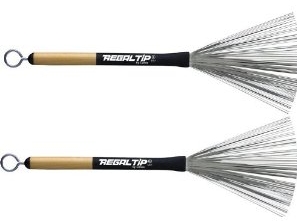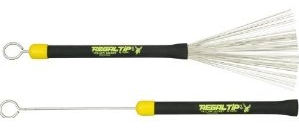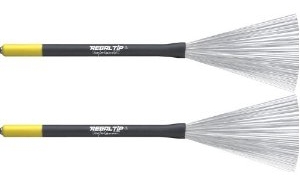First, some background information: A list of instructional videos for brushplaying is a good starting point for either learning to master this aspect of drumming, or to brush up on your technique. See this page for examples of excellent technique performed by some top brush masters. Brushes and drum heads have a close relationship, so you may want to check out Part 1 and Part 2 of a pair of posts focused on drum heads. And some history of brushes is a way to trace back to the beginning. One final note: a frequent question is which practice pad supports brush practice? Answer: while there are a number on the market (Remo makes an excellent one), my advice is to save your money and use a pizza box! I am serious.
On to brush models. My personal favorite is the Regal Tip BR-584W Ed Thigpen retractable model.

For the longest time I used fixed handle brushes, and was in love with Regal Tip's Clayton Cameron model. I grew tired of carrying them in their plastic tubes to protect the wires because those tubes take up a lot of real estate in stick bags. At first the Ed Thigpen model felt too heavy, but after prolonged playing (and switching among a few other brush brands and models) I came to appreciate the way these brushes balanced, and also the wood end at the rear of the handle opens an entire, new set of sounds when used to strike cymbals, drum rims, and even drum heads (think Joe Morello on Three To Get Ready).
While I love the Ed Thigpen model I also carry Regal Tip's BR-575-YJ Yellow Jacket retractable brushes in my stick bag.

The wires flex noticeably more than most brush models I have used. In fact, the feel of the wires is similar to the feel of nylon, while still producing the distinctive sound that only a wire brush can provide. The wire is such a thin gauge that you may encounter problems with them falling out under heavy playing (I have heard a few such stories on various forums). I use mine for ballads because of the way the bristles flex. And unlike other brushes, these do not catch on new heads. They also require less break-in time.
My former favorites and still a model I love) is the Regal Tip Cameron Clayton model.

The wires seem to be the same gauge as the ones in the Regal Tip's BR-575-YJ Yellow Jacket retractable brushes Pair. They are ideally suited to ballads, and because they are slightly longer than fully extended wires in the Yellow Jacket model, you can use them for heavier playing as well. Another plus about the wires (and the overall balance of the brush itself) is they lend themselves to rim rolls.
I love the balance. Clayton Cameron came up with the basic design and it suits me perfectly. I am pretty sure the length of the handle, diameter and weight are factors. And the wires may also contribute.
The metal tips in the ends of the handles are good features. They work beautifully for getting that zing sound when dragging the end around the circumference of a cymbal using the lathed tonal grooves.
Why don't I still use them exclusively? I have grown to like the convenience of retractable handle brushes. Those do not need to be housed in a plastic tube to prevent the wires from bending and snagging. Also, I have developed the habit of adjusting the fan on my right brush - using the handle - to calibrate how legato or staccato I want to play. I can also do that with the fixed brushes using a rubber band at the top of the wires and sliding it down, but the handle is easier and quicker. I still carry a pair of these brushes in my main stick bag because there are times when it's the right brush for the music.
I have not scratched the surface of the models I plan to discuss (I still have over fifteen other ones to cover). However, those can wait until I have the time to write subsequent articles. In the next post I'll cover an additional three to five models. Until then, enjoy.
No comments:
Post a Comment